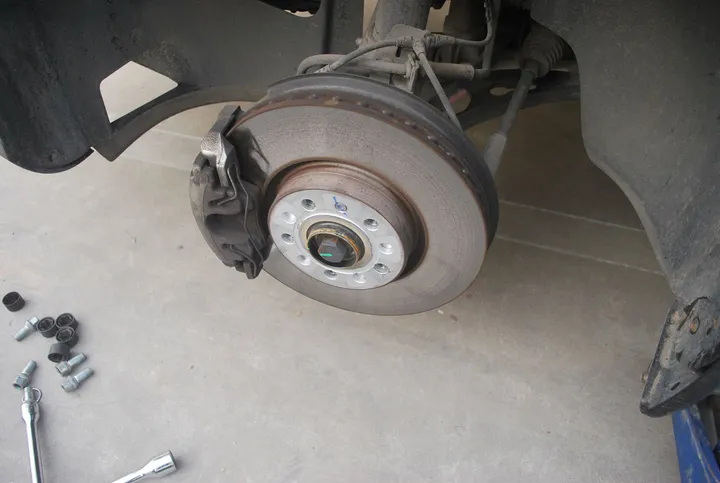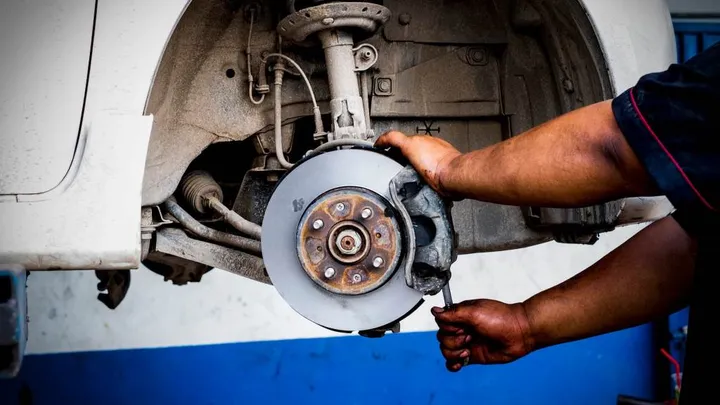


Brake pedal vibrations refer to the undesirable shaking or pulsating sensation felt through the brake pedal when applying the brakes in a vehicle. This vibration can range from a subtle pulsation to severe shuddering, depending on the underlying cause and severity of the issue. Brake pedal vibrations are typically accompanied by a corresponding vibration in the steering wheel and, in some cases, the entire vehicle body.

Brake pedal vibrations can stem from various issues within the braking system or related components. Here are some of the most common culprits:
| Cause | Description |
|---|---|
| Warped or Damaged Brake Rotors | Brake rotors can become warped due to excessive heat buildup, uneven wear, or improper installation. When the brake pads make contact with the warped surface, it creates an uneven friction pattern, causing vibrations. |
| Worn or Damaged Brake Pads | As brake pads wear down, they can develop an uneven surface or become contaminated with debris, leading to inconsistent contact with the rotor and resulting in vibrations. |
| Brake Caliper Issues | Stuck or seized brake calipers can cause uneven brake pad pressure on the rotor, while misaligned or improperly mounted calipers can lead to uneven pad contact, both contributing to vibrations. |
| Suspension or Steering Component Issues | Worn ball joints, tie rod ends, or control arm bushings can affect wheel alignment and stability, indirectly causing vibrations during braking. |
One of the most frequent culprits behind brake pedal vibrations is warped or damaged brake rotors. These rotors are responsible for providing a smooth surface for the brake pads to grip and slow down the vehicle. However, over time, they can become warped due to excessive heat buildup, uneven wear, or improper installation.
When the brake pads make contact with the warped surface of the rotor, it creates an uneven friction pattern, causing the pedal to vibrate or pulsate during braking. This vibration is a clear indication that something is amiss with the braking system, and it should not be ignored.
Brake pads are the consumable components that apply friction to the rotors, slowing down the vehicle. As they wear down, they can develop an uneven surface or become contaminated with debris, leading to an inconsistent contact with the rotor. This inconsistent contact can result in vibrations during braking, which are transmitted through the brake pedal.
Brake calipers are the components that house the brake pads and apply the clamping force to the rotors. If a caliper becomes stuck or seized, it can cause uneven brake pad pressure on the rotor, leading to vibrations. Additionally, if the caliper is not properly aligned or mounted, it can cause the brake pads to make uneven contact with the rotor, resulting in vibrations.
While not directly related to the braking system, issues with the suspension or steering components can also contribute to brake pedal vibrations. Worn ball joints, tie rod ends, or control arm bushings can affect the alignment and stability of the wheels, leading to vibrations during braking.
As a mechanic, diagnosing the root cause of brake pedal vibrations is crucial to ensure proper repair and prevent further damage. Here's the comprehensive process I typically follow:
Visual Inspection
Perform a thorough visual inspection of the braking system components
Carefully examine the brake rotors for any visible signs of warping, scoring, or uneven wear
Check the brake pads for wear and contamination, as these can contribute to vibrations
Road Test
Conduct a road test to observe the behavior of the vibrations
Pay close attention to when the vibrations occur
If they occur only during braking, it may indicate an issue with the braking system itself
If the vibrations are present at all times, it could point to a problem with the suspension or steering components
Observe the feel of the brake pedal
If the pedal pulsates or vibrates during braking, it's a strong indicator of a problem with the brake rotors or pads
Brake Component Inspection
Perform an in-depth inspection of the brake components
Check the brake calipers for proper operation and alignment, looking for any signs of sticking or seizing
Inspect the suspension and steering components for any signs of wear or damage that could contribute to the vibrations
Once the cause of the brake pedal vibrations has been identified, it's time to address the issue with the appropriate repair. Here are the common repair procedures I follow:
| Repair | Description |
|---|---|
| Brake Rotor Replacement or Resurfacing | If the brake rotors are warped or severely damaged, they may need to be replaced or resurfaced (machined) to restore a smooth surface. Resurfacing is typically more cost-effective but can only be done if the rotors have sufficient remaining thickness. |
| Brake Pad Replacement | If the brake pads are worn or damaged, they should be replaced with new, high-quality pads. It's recommended to replace the pads in axle sets (both front or both rear) to ensure even braking performance. |
| Brake Caliper Repair or Replacement | If the brake calipers are stuck or misaligned, they may need to be repaired or replaced. This may involve cleaning, lubricating, or replacing the caliper components, depending on the severity of the issue. |
| Suspension or Steering Component Replacement | If the issue is related to worn suspension or steering components, the affected parts (such as ball joints, tie rod ends, or control arm bushings) will need to be replaced to restore proper alignment and stability. |
If the brake rotors are warped or severely damaged, they may need to be replaced or resurfaced (machined) to restore a smooth surface. Resurfacing is typically more cost-effective, but it can only be done if the rotors have sufficient remaining thickness. If the rotors are too thin, they must be replaced.
If the brake pads are worn or damaged, they should be replaced with new, high-quality pads. It's recommended to replace the pads in axle sets (both front or both rear) to ensure even braking performance.
If the brake calipers are stuck or misaligned, they may need to be repaired or replaced. This may involve cleaning, lubricating, or replacing the caliper components, depending on the severity of the issue.
If the issue is related to worn suspension or steering components, the affected parts (such as ball joints, tie rod ends, or control arm bushings) will need to be replaced to restore proper alignment and stability.

While brake pedal vibrations can be repaired, it's always better to prevent them from occurring in the first place. Here are some maintenance tips I recommend to my customers:
Regular Brake Inspections
Have your brakes inspected regularly by a qualified mechanic
This allows for the identification of potential issues before they become more severe
Timely repairs can prevent further damage and ensure safety
Proper Driving Habits
Avoid excessive braking or riding the brakes
Excessive braking can cause excessive heat buildup and accelerate brake component wear, leading to vibrations
Routine Brake Fluid Changes
Follow the manufacturer's recommended intervals for brake fluid changes
Ensure the fluid remains in good condition and free of contamination, which can contribute to vibrations
Suspension and Steering Maintenance
Keep up with regular maintenance and inspections of your vehicle's suspension and steering components
This helps prevent premature wear and ensures proper alignment, which can indirectly affect the braking system and contribute to vibrations
The cost of repairing brake pedal vibrations can vary depending on the specific cause and the extent of the repairs needed. Here are some approximate cost estimates based on my experience:
| Repair | Cost Range |
|---|---|
| Brake Rotor Resurfacing | $50 to $150 per axle |
| Brake Rotor Replacement | $100 to $300 per axle |
| Brake Pad Replacement | $100 to $300 per axle (including labor) |
| Brake Caliper Repair or Replacement | $150 to $500 per caliper (including labor) |
| Suspension or Steering Component Replacement | $100 to $500 or more, depending on the component |
It's important to note that these cost estimates are approximate and can vary based on your location, the make and model of your vehicle, and the labor rates of the repair shop. It's always recommended to obtain a detailed estimate from a qualified mechanic before proceeding with any repairs.
Brake pedal vibrations can be a concerning issue, but with proper diagnosis and repair, they can be resolved effectively. As a mechanic, I've seen firsthand the importance of addressing these vibrations promptly to ensure the safety and reliability of your vehicle's braking system.
By following proper maintenance practices, such as regular brake inspections, avoiding excessive braking, and keeping up with routine fluid changes and component replacements, you can help prevent brake pedal vibrations from occurring in the first place.
If you do experience brake pedal vibrations, don't hesitate to bring your vehicle to a qualified mechanic for a thorough inspection and repair. Addressing these issues promptly can save you from more costly repairs down the line and ensure your safety on the road.
Remember, your braking system is a critical component of your vehicle, and its proper functioning should never be compromised. With the right knowledge and preventive measures, you can enjoy a smooth and safe driving experience, free from the unsettling vibrations of a compromised braking system.
Here is an FAQ section with 10 additional questions related to brake pedal vibration based on the article content:
Brake pedal vibration is usually caused by issues like warped brake rotors, worn brake pads, stuck brake calipers, poor wheel alignment, or suspension problems. It indicates an abnormality in the braking system that needs attention.
Yes, brake pedal vibration is considered a serious issue as it can indicate potential safety concerns and further damage to brake components if left unaddressed.
It is not recommended to continue driving with a vibrating brake pedal for an extended period, as it may lead to unsafe braking conditions and further deterioration of the brake system.
If you experience a pulsating sensation in the brake pedal or steering wheel during braking, it is likely an indication that your brake rotors are warped or excessively worn and need replacement.
Yes, worn suspension components like ball joints, tie rods, or shocks can affect the vehicle's stability during braking, leading to uneven brake application and vibration in the pedal.
It is generally recommended to replace brake pads and rotors together, as new pads may not make proper contact with old, worn-out rotors, leading to vibration and uneven braking.
It is advisable to have your brakes inspected by a qualified mechanic at least once a year or as recommended by your vehicle's manufacturer to catch potential issues early.
Yes, aggressive or sudden braking can generate excessive heat and contribute to warping or uneven wear of brake rotors, leading to brake pedal vibration over time.
Yes, avoiding aggressive braking, using high-quality brake parts, and scheduling regular brake inspections can help prevent brake pedal vibration and extend the life of your brake components.
Yes, air in the brake lines or contaminated brake fluid can lead to a spongy or inconsistent brake pedal feel, which may manifest as vibration during braking.

Sarah isn't your average gearhead. With a double major in Mechanical Engineering and Automotive Technology, she dived straight into the world of car repair. After 15 years of turning wrenches at dealerships and independent shops, Sarah joined MICDOT to share her expertise and passion for making cars run like new. Her in-depth knowledge and knack for explaining complex issues in simple terms make her a valuable asset to our team.



